

 The South African
The South African
by Dr C Mazansky
In order for the reader to understand and enjoy cartophily, some background to this hobby and the companies producing the cigarettes and distributing the cards is provided.
BACKGROUND HISTORY OF CIGARETTE AND TRADE CARDS
Sir Walter Raleigh brought the tobacco leaf to England and introduced smoking, primarily to the aristocracy. With industrialization and improved farming methods, the product soon became available to all classes of society. The first use of any type of card began in the eighteenth century as a form of advertising by tradesmen. Cigarette cards were initially used as stiffeners to the soft packets of cigarettes but very rapidly assumed the advertising aspect previously reserved for trades people. The next step in the evolution of cards was to print some form of pictorial information with or without associated descriptive detail, in addition to the direct cigarette advertising. The concept of a series of cards on the same subject matter, was a clever approach to stimulate cigarette sales and ultimately led to the hobby of cigarette card collecting (cartophily). The firm W D and H O Wills was the first British company to produce cards in England in 1888. John Player and Sons followed in quick succession. In the last decade of the nineteenth century the biggest firm, Ogden's, had developed its own cards. In fact in 1894, it introduced the Guinea Gold card which, over a period of 13 years, produced thousands of photographs of politicians, war leaders and various people accomplished in the cultural spheres of life.
CIGARETTE COMPANIES AND CARD PRODUCTION
After James Duke had gained control of almost the entire American cigarette trade in the nineteenth century, he tried to achieve a similar status in the British market. At the time that he acquired the firm of Ogden's Ltd in 1901, there were 150 cigarette companies in the United Kingdom. The British recognized the danger of his takeover efforts and amalgamated into a large group called the Imperial Tobacco Company (ITC). It included such famous companies as Wills, Lambert and Butler, Player, Smith, Hignett, Ringer, Biggs and Adkins. Faulkner and Churchman subsequently joined this group. Resolution of this trade war resulted in the Imperial Tobacco Company and the American Tobacco Company operating independently in their respective countries and separating off their subsidiaries worldwide to form a joint company - British American Tobacco Company (BAT) - which operated in other areas in the world. All of these British and American companies issued enormous numbers of sets under their individual company and even brand names. Some of these sets were identical, originating from a common supplier.
Since it was predominantly men who smoked, the themes chosen were those considered most likely to attract them. Thus actresses, beauties and sports were popular themes. The many armed conflicts of the Victorian era gave rise to topics covering this sphere. There were three major periods of cigarette card production: 188O to 1900, 1900 to 1939, and, finally, 1945 to the present day. Each era produced an enormous number of sets but it reached its heyday in the period between the two World Wars when over 2 000 series were issued. Unfortunately, most of the cards produced before the Second World War have disappeared. It is interesting that during the earlier stages of the First World War a great deal of activity occurred, to take advantage of both the public's interest and to promote the war effort through propaganda. However, since the cards were very detailed, extremely accurate and had a wide circulation, they were subject to censorship. In 1920, J Taddy & Co. went out of business. Their cards were of an extremely high quality and only very limited numbers exist and, hence, prices tend to be very high for their sets.
BEGINNING A COLLECTION
There is virtually no limit to the type of collection that can be accumulated. For the military enthusiast, some focus is already established but within it there are diverse opportunities. Methods of collecting may also vary. One might collect either sets or types of cards, which are usually single cards from a series or, in certain cases, of rare and expensive cards when the complete set is unavailable. Alternatively, a collector might choose only those cards from a more general series which accord with his interest. Further, collecting may be confined to a specific period or to certain manufacturers. Most cards were published on rectangular pieces of cardboard but certain novelty issues existed as well, for example, die-cut or silk cards or sectional series.
To encourage collecting, some firms produced albums to accommodate the sets. However to obtain a complete series subsequent to cessation of publication, became technically very difficult. Therefore in 1927, Colonel C L Bagnall formed the London Cigarette Card Company Ltd., which bought, stocked, traded, sold and auctioned cards. Other card dealers proliferated and held regular auctions. A significant volume of literature is available to the collector to enable him to become more familiar with the subject. These are important reference sources and fulfil the need to remain up to date and involved. Storage, display and cataloguing is an important consideration once the collection has reached a significant size. This is readily accomplished by the use of plastic slip-in leaves which insert into albums using metal ring binders.
Cards are similar to stamps and there are obviously financial considerations involved. The value of a card depends on a number of factors including availability, quantity and quality. The military subject involves all of these and varies from low priced sets to extremely expensive ones and the range extends from several rands to several thousand rands for a particular set. Prices have tended to rise dramatically in the last few years and so for the serious collector, a significant investment mar materialize.
Cartophilic societies around the world provide further stimulation, ongoing research and information to maintain the interest of its members.
THE MAJOR COLLECTIONS
No better indication exists for the stature ot cigarette card collecting and the importance placed on their role in society than by describing a few major collections which are held by some of the world's most prestigious institutions. The best collection of American cards was bequeathed by Jefferson Burdick to the Metropolitan Museum of Art in New York. Hundreds of albums are available for study in the Print Room. Today, the biggest collection belongs to Mr E C Wharton-Tigar, MBE, President of the Cartophilic Society of Great Britain, who has agreed to donate his entire collection to the British Museum which will provide a special building to house his collection. Another major collection is the M L Horne and B R Lillington Collection in the Bodleian Library at Oxford University. Of the 71 albums in the collection, the armed forces fill ten. They contain a number of superb sets such as Smith's 'Boer War Series'; Player's 'England's Military Heroes'; Gallagher's 'South African Series'; and Salmon and Gluckstein's 'Heroes of the Transvaal War'.
THE MILITARY THEME
In the strict sense, the term 'military' has a very specific connotation. It is in fact the military component of the total armed forces and is that part which 'pertains to soldiers or army or land warfare'. Within this military section of the armed forces, there is an enormous number of sets covering all aspects of soldiers, their accoutrements, armed conflicts, and personalities.
The account which follows may manifest a distinctly British bias. There are many obvious reasons for this. The most important is that it was British cigarette manufacturers who issued these cards, British artists and historians who did the research for them, and it was at the height of the British Empire that so many of these cards were produced. The detailed description on some of the cards may in some cases seem somewhat distasteful in terms of manner of description as well as in the use of certain terminology. However, one ought to be aware of the era in which many of these were produced. It should be seen in the context of an era of not only tremendous pride (and justifiably so) in the power and accomplishments of the British Empire, but it was also unfortunately an era of jingoism as well as a somewhat superior attitude. Despite this emotional perspective, the beauty and value of these cards are worthy of admiration.
Military cigarette cards cover a broad spectrum of interest and are best presented under the following headings, which classification has been developed by the author. Since no previous classification existed, the development of this is somewhat arbitrary but is based on a personal collection which is of a sufficiently broad spectrum as to include most topics of interest. However, ongoing enhancement of the collection might naturally lead to a modification of this classification.
British Empire, Royalty and Notabilities
Information on cigarette cards relative to South Africa extends from the late eighteenth century to just prior to the Second World War. This also happened to correspond with the most vigourous formative years of the country and many events occurred and personalities were involved in this dynamic evolution. The cards that will be examined will be of the appropriate historical background as well as the regal, political, civilian and military celebrities who both shaped and were caught up in the events.
Aspects of the British Empire
Churchman's 'History and Development of the British Empire' (1934) has several cards in the series which cover the earliest aspects of the Empire relative to South Africa. The first one (card 45) is titled 'Union of South Africa'. The picture on the front of the card shows the British first occupying the Cape Colony in 1795. The brief description on the back gives a capsule of British involvement right through to the Union of South Africa. It describes their occupation of the colony in 1795, the restoration to the Dutch in 1803, its re-occupation in 1806, the formation of the separate colony of Natal in 1843, the establishment of the Transvaal and Orange River Republics, the grant of responsible government after the Anglo-Boer War (1899-1902) in 1906 and 1907 and finally the self-governing colonies becoming united in the Union of South Africa in 1910. Cards 46, 47 and 48 are respectively titled 'The Cape of Good Hope', 'Natal' and 'The Transvaal' with descriptions of the various colonies including their history. It is interesting to note that in 1814, the Cape was finally ceded to Great Britain for an amount of six million pounds!
John Player's 'British Empire Series' (1904) is a set of 50 cards depicting aspects of life in the various colonies throughout the world. Number 4 shows a South African postman and has on the back of the card this description: 'the native post runner wears no clothes, so he has no pockets and experience has shown that the surest and cleanest way of getting a letter delivered is to make the bearer carry it in a cleft stick where he has it always in view yet does not soil it with his hands'. Three other cards in the sequence show a Zulu carriage, a wagon crossing a drift and a jinricksha in Natal. Both the above description of the postman and subsequent ones have a rather derogatory tone distasteful in today's climate, but understandable in the context of the early Edwardian period when the set was published.
Notabilities
J Wix and Company in its 'Kensitas' series of cigarettes published a set in 1937 called 'Builders of the Empire'. In essence, it is a set depicting personalities responsible for building the Empire and covers royalty, other nobility, political and military personalities. Thus pertinent ones include several of the rulers of Britain, Lord Milner and Joseph Chamberlain, who was Colonial Secretary in the British Parliament in 1895 and responsible for sending Milner to South Africa in 1897 as High Commissioner. Kitchener and Roberts are included as well. Cecil Rhodes was obviously included and, interestingly, General Botha The latter card is based on a portrait of the General in the National Portrait Gallery. He was held in the highest esteem by the British as can be judged by the contents of the back of the card which describe him as one of the ablest and bravest of the Boer commanders in the Anglo Boer War. He was described as having to carry out the peace terms and thereafter having become a staunch friend of Great Britain, one of her more trusted Imperial statesmen and one of South Africa's representatives at the Peace Conference in Versailles in 1919. The same set also contains a picture of Sir Harry Smith. The back describes his various military feats in South Africa, including his winning the Frontier War of 1836, his defeat of the Boers in South Africa in 1848, after becoming governor the year before, and his winning of the subsequent Native Uprising. It further describes his measures to strengthen British control in South Africa and how his name and that of his wife have been perpetuated there.
Brooke Bond Tea (1969) produced a set of 50 'Famous People' containing pictures of Lord Baden-Powell and Cecil Rhodes. An entertaining card is from the trade card set by A. B. and C. on 'Winston Churchill'. Card number three is a picture of the poster written in Afrikaans offering 25 pounds for the reward for Churchill's capture, either dead or alive!
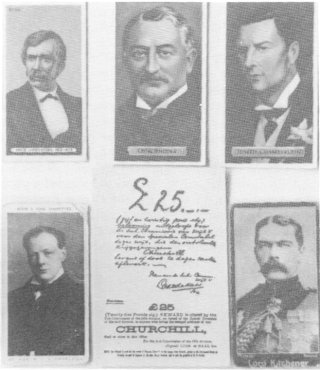
Notabilities
Royalty
Since the history of cigarette cards relative to South Africa covered a period of nearly 150 years, several monarchs ruled over the British colonies in the region. As the monarchs were the supreme commanders of British and Colonial forces, collections of cigarette cards relative to them featured prominently. Without question, Queen Victoria figuratively and literally reigns supreme as the most important ruler both in terms of the number of significant military events that occurred during her reign as well as because of the length of her rule.
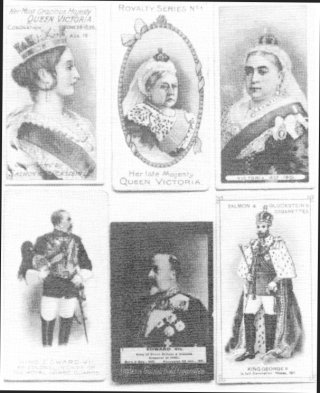
Royalty
During her long reign from 1937 to 1901, there was not a year that the British were not involved in some form of military action throughout the Empire. Africa, and particularly South Africa, featured very prominently during this period. Apart from the obvious importance of the Zulu War and First and Second Anglo-Boer Wars, there was a military occupation of Natal in 1843, an expedition against the Boers in 1845, the War of the Axe in 1846 and 1847, action at Boomplaats against the Boers in 1848, the Frontier Wars of 1850 to 1853 and 1877 to 1879, the Gaika War in 1878, the Expedition to Bechuanaland in 1884 and the Jameson Raid in 1896. The combined effects of her long reign, the many events occurring in Britain and its colonies and the active development of the first phase of cigarette card production, resulted in many series devoted entirely or partially to pictures of Queen Victoria. Salmon and Gluckstein in 1897, published 'Her Most Gracious Majesty Queen Victoria,' a set of six cards illustrating stages in her life from the time of her birth until 1897. Gallaher's 'Royalty Series' included a picture of the 'late Queen Victoria'. Richard and Burton and several other manufacturers had cards as well. Lever Brothers 'Celebrity Series Number One' (1900) had a large card framed with a picture of Queen Victoria.
However, the monarchs who ruled over South African colonies during the period of interest induded Georges III, IV, V and VI, William IV and Edward VII and VIII. In 1902, Taddy published the 'Coronation Series' which showed various aspects of the Coronation Ceremony by illustrating monarchs from the election of Alfred the Great in AD 1086 through to Edward VII. George III's coronation on 22 September 1761, George IV's in 1821, William IV's on S September 1831, and Edward VII's in 1902 are all included. Separate sets by Wills's in 1902 and Salmon and Gluckstein in 1911 respectively, titled 'Coronation Series are devoted exclusively to the coronations of Edward III and George V.
Other illustrations of Edward VII are in the various Ogden's sets of cards. George V is illustrated in J Wix's 'Kensitas' series of 'Builders of the Empire' described earlier.
British Regiments
It is obvious that with so many military campaigns having taken place in South Africa, many of the British regiments fought there. This was particularly so in the Anglo-Boer War (1899-1902) when nearly a quarter of a million British soldiers were involved in the conflict. One might appropriately give a full list of all cigarette card series dealing with British regiments and imply that they were at some stage involved in South Africa. However, mention will only be made of some of those sets which list or illustrate a specific connection with South Africa. Carreras's 'History of Army Uniforms' (1937) has 50 cards in the series and the last one is an illustration of an infantryman in the Anglo Boer War. The back describes the revolutionary changes in wartime military dress that this campaign produced. It was the first time that the whole British Army which went to South Africa, was clad in khaki. The back of this card further describes how khaki then became British standard uniform for general purposes of the regular and territorial armies. Law's set of 'Types of British Soldiers' (1914) has a picture of a corporal of the Cape Mounted Riflemen in review order. There is no description on the back of this card.
W and F Faulkner's second of two sets of 'Our Gallant Grenadiers' (1903) shows on card number 40 the Guards entering Pretoria in 1900 with a description on the back of their involvement in this conflict, and how they were the first regiment to march past Lord Roberts when he took Pretoria.
Colonial and Territorial Troops
A set by Gloag titled 'Home and Colonial Regiments' shows a picture of the Cape Mounted Riflemen. It is different from the one described above and shows the soldier in his blue uniform, white helmet and black boots with spurs.
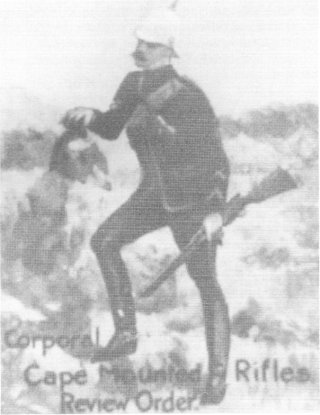
Colonial and Territorial Troops
The Wholesale Tobacco Supply Syndicate and Cohen and Weenen, in 1901, each issued a set titled 'Home and Colonial Regiments' which was identical and had a picture of a Natal Carbineer in khaki uniform.
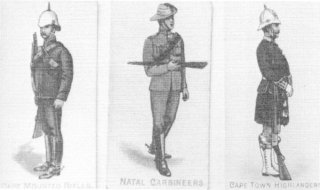
Another set titled 'Colonial Troops' was issued by many manufacturers including Godfrey Phillips, Cohen and Weenen, and Harvey and Davey. The four have examples of the Cape Mounted Riflemen, Cape Town Highlanders, and General Lord Kitchener. J and F Bell published 'Colonial Series' (1901) which has a picture on the front with a descriptive back. The Natal Carbineers, Imperial Light Horse and the Transkei Mounted Rifles are included. The back of the card of the Carbineers describes involvement of this volunteer corps from the time of Sir Theophilus Shepstone when he crowned King Cetewayo until their involvement at Isandhlwana and in the Anglo Boer War. W Faulkner's 'Our Colonial Troops' (1900) had three cards in their set; a Cape Town Highlander, a Cape Mounted Rifleman and, again, a Natal Carbineer in their series of 100 cards. These were plain backed cards, without any description.

John Player issued, in 1938, 'Military Uniforms of the British Empire Overseas'. Cards 1 to 4 relate to South Africa. Detailed description on the back is included. The Cape Town Highlanders, Kimberley Regiment, Witwatersrand Rifles, and Regiment Louw Wepener are illustrated. A description on the back of the latter describes it as an Orange Free State regiment incorporated into the Defence Forces with the formation of the Union of South Africa.
Victoria Cross Heroes
This section features very prominently in South African military events. Primarily because of the enormity of the conflict of the Anglo-Boer War (1899-1902), many of these awards were made during it. Several manufacturers issued sets varying from one to many related specifically to the Victoria Cross, and covering the period from its inception to 1965. However, most issues were up to and including the First World War. With regard to South Africa, interest in this section ended in 1902.
John Player's 'The Doncella History of the VC' published in 1982 shows in card number 7 how Lance Corporal Joseph John Farmer won his award in the massacre at Majuba. A descriptive back provides details of this episode. Cards 5 and 6 have pictures and descriptions of the recipients in the Zulu War and cards 8 and 9 from the Anglo-Boer War (1899-1902). The major issuer of sets relative to the pertinent period in South African military history was Taddy and Company. Between 1901 and 1904, it issued six sets totalling altogether 125 cards sequentially numbered. The first two sets and the last set were titled 'Victoria Cross Heroes' and the third, fourth and fifth sets were titled specifically, 'VC Heroes - Boer War'. In the first set, card number 15 shows how Sergeant O'Toole of the Frontier Light Horse won his award. In set two, cards number 25 to 27 covered the Zulu War. The first one of these describes how Private Hook won his award at Rorke's Drift. The illustration on the front shows him stabbing a Zulu warrior with his bayonet as the latter was passing through a hole in the wall of the hospital. Card number 27 shows Captain, Lord William Beresford of the 9th Lancers at the Battle of Ulundi.
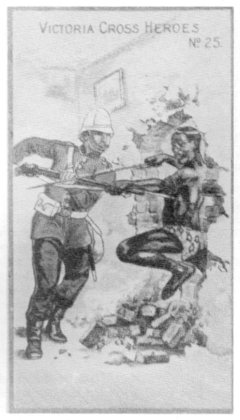
There are two cards dealing with the first Anglo-Boer War (1880-1881) or as titled on the cards 'The Transvaal War'. An award was given at Majuba to Lance Corporal Farmer as described previously and the other to Private Dugan of the 1st Dragoon Guards at Laing's Nek. These first two sets have descriptive backs. The three sets devoted to recipients of the Anglo Boer War are numbered from 41 to 100 and have a description underneath a portrait of the recipient. All ranks are included. Although not all the awards were given during this campaign, all the recipients were participants in the War. This applied more to the early set rather than the later ones. For example, Field Marshal Roberts won his award during the Indian Mutiny of 1857, Lieutenant General Sir George White won his award in the Afghan War of 1879 as did Lieutenant Colonel Dick Cunyngham. However, later sets were mainly of those of the lower ranks who won their awards during the campaign. Thus, Sergeant Martin won his award for 'Conspicuous Bravery During the Siege of Ladysmith in Carrying Important Dispatches through the Boer Lines'. Private Kennedy of the Highland Light Infantry, was 'awarded the Victoria Cross for gallantly carrying a wounded comrade under a heavy fire to a place of safety, Dewetsdorp November 1900'.
Ogden's 'Victoria Cross Heroes' (1901-1902) is a set of 50 cards. Fourteen of these cards are related to events in South Africa. The front of the card shows a coloured illustration of the event leading to the award, with many of the cards having an inset picture of the recipient in the front and a brief description of the event on the back. Thus the eighth card in the series shows Lieutenant Chard and Lieutenant Bromhead with their head insets and an illustration of them fighting the Zulus at Rorke's Drift. Most, however, relate to the Anglo-Boer War (1899-1902). B Morris and Sons published, in 1900, a set titled 'Boer War'. In fact, the set is devoted entirely to VC heroes. The front shows an illustration of the recipient and beneath there is a description with the name of the recipient, his regiment, and how he won his Victoria Cross.
Anglo-Boer War (l899-1902)
For a variety of reasons, the three year, Anglo-Boer War resulted in a proliferation of card sets by a wide variety of cigarette manufacturers. A number of different manufacturers issued the same type of sets and these are designated accordingly. The popularity of military series in general, the corporate trade war between the American and British cigarette compnay manufacturers and the size and duration of the war, together with its tremendous political implications, were the major factors for this proliferation. Gallagher, in 1901, issued 'The South African Series'. This is a non-descriptive set numbered from 101 through to 211. Each card in the set is coloured and has a full length illustration of commissioned officers, mostly in full dress uniform, who participated in the war. Underneath the illustration is the name and title of the individual and in many instances the regiment to which he was attached.

Only three cards were of non-commissioned officers. Salmon and Gluckstein issued in 1901 'Heroes of the Transvaal War' which were head and chest coloured pictures of members of the British forces and again almost exclusively officers. A brief description on the back, written in the present tense, explains how the individual was involved. Thus, for example, Brigadier General Hector MacDonald is described on the back of his card as having joined the Gordon Highlanders in 1870, risen through the ranks, served in the Afghan Campaign, and, on his way home, having been sent to the Transvaal where he fought at Majuba Hill, and then greatly distinguished himself at the relief of Gordon and at the Battle of Omdurman. The very valuable numbered set of 50 cards by F J Smith 'Boer War Series' (1901) again shows a coloured illustration of British officers in either dress or service uniform, in various poses, with a descriptive back. Card number 6 is of Lieutenant General Sir William Gatacre who is described on the back of the card as having been born in 1843 and having entered the army in 1862. He served in a variety of campaigns and at the outbreak of the Anglo-Boer War was appointed to command the Third Division. Card number 29 is of Brigadier General Brabant, who is described as having been appointed to command the Colonial Forces operating in South Africa during the war. Card number 47 is of Surgeon Major W Babtie who was of the Royal Army Medical Corps and repeatedly distinguished himself.
The only set devoted entirely to the Boers was issued by Taddy in 1901 called 'Boer War Leaders'. It is a set of 20 cards with head-and-shoulders coloured drawings and brief descriptions of the individuals beneath. Card number 1 is of Petrus Jacobus Joubert. The description is 'Commandant General and Vice President of the South African Republic from 1881 to 1900. A man as generous and honourable as he was valourous'. Christian Botha, Generals Christian de Wet, De la Rey, Cronje, etc., are all included. The descriptions of these people were highly complimentary. It is important to note that because this war was considered the last of the 'gentlemen's wars' it is not altogether surprising that the 'enemy manufacturer' could be effusive in its praise of the opponent.
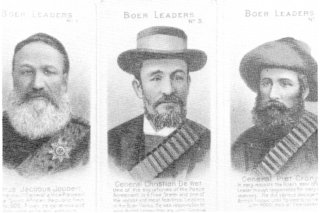
An interesting set issued by Wills in 1900 is called 'Boer War Medallions'. It is a set of eight medallions which could be hung either from a necklace or a brooch. The medallions were made of brass, and had stamped on them the image of and the name of, among others, Queen Victoria, Lord Kitchener, Lord Roberts, etc. Kipling's, 'A Gentleman in Khaki' is the subject of the eighth medallion.
Faulkner's 1901 'South African War Scenes' consists of 25 black-and-white cards which are photographs with a one-line description beneath. Thus some of them are titled 'The Duke of Cambridge's Own at stable work, Springfontein'; 'Lord Roberts Leaving Winburg Hospital after Visiting the Wounded'; 'Nurses at General Hospital Winburg'; 'Officers of Seventh Battalion Imperial Yeomanry at Orange River'; etc.
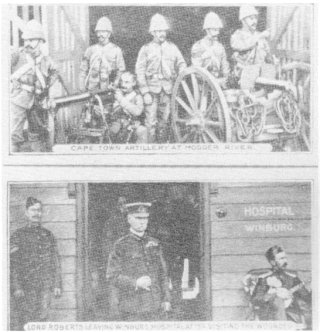
W D Wills issued a set titled 'Transvaal Series' consisting of 66 cards but, including all the varieties, the complete set comes to almost 300 cards. They are black-and-white photographs of the various individuals involved in the conflict. They have detailed descriptions on the backs. Again, there are the familiar names and faces of Sir Alfred Milner, the Right Hon C J Rhodes, the Hon W P W Schreiner, Major General Sir W F Gatacre, Lieutenant General Lord Methuen, Major General Baden-Powell, Major General Sir W P Symons, etc. This set also includes General Cronje and President Steyn.
Militaria
It is said that the accoutrements of the British soldier's and officer's uniform are what provided so much of the flair and contributed towards the pomp associated with the British army. The cigarette card manufacturers took great advantage of this and issued innumerable sets illustrating all aspects of militaria. These included sets of regimental colours and standards, caps, badges, flags, medals, ribbons, crests, headdress, etc. South African-related components are included, directly or indirectly, to a greater or lesser extent, depending on the subject. Thus in the area of the Regimental Standards, Colours and Banners, the only South African component is the inclusion in the inscription of the battle honours won by the various regiments that fought there. The concept of Battle Honours is a distinctly British phenomenon and over the centuries these were awarded to regiments when they distinguished themselves in a particular battle or war.
A very famous set by John Player issued in 1900 and titled 'Military Series' is made up of 50 cards showing, on the front of each, a head and shoulders picture of soldiers of famous regiments and corps of the British army bordered in front with two flags obliquely directed towards each other bearing the standard, colours, regimental wreaths, and guidons. On the back of each card is listed the name of the regiment and all the battle honours awarded. Thus for example, the card of the Scots Guards has listed on the back its last battle honour, South Africa 1899. The Argyll and Sutherland Highlanders have listed South Africa, 1846-7, 1851-2-3, 1879, 1899. The 9th Lancers have listed on the back South Africa 1899, etc. Another set by Player issued in 1930 called 'Regimental Standards and Cap Badges' has on the front a picture of the colour, guidon, etc. and next to it the cap badge. The back contains a description of the regiment and the colour it obtained and some information on it. For example, the card on the First Battalion of the Royal Sussex Regiment decribes on the back how the colour was of an old pattern but in fact was issued shortly after the South African War. Gallagher issued in 1912 its 'Regimental Colours and Standards' which similarly on the front has an accurate illustration of the colour, standard, drum colour, or guidon. On the back of the cards is given a list of the battle honours of that particular regiment. In this series too South Africa features prominently; predominantly, in the second half of the nineteenth century. Some examples include, in addition to those previously mentioned, the First Dragoon Guards, the Queen's Royal West Surrey Regiment, the Buffs, Prince Albert's Somerset Light Infantry, the Duke of Cambridge's Own Regiment (the 17th Lancers) and many others.
In Player's unissued set of 'Decorations and Medals', there are several relative to South Africa. These are numbered cards with the medal and ribbon illustrated on the front of each and a description on the back. Number 14 is the South African medal, 1834-1853, described as... 'the first South African medal awarded for services during the campaigns against the Kaffirs of 1834-5, 1846-7, and 1850-1-2-3'. The illustration shows a lion crouching in front of protea bush with the date 1853 in the exergue. A similar medal was issued for the campaign of 1877, 78 and 79 but differed from the former, by having a shield and spears in the exergue. A South African medal was issued as South Africa, 1899-1902, Queen's Medal. In the same set is the Cape of Good Hope General Service Medal and a Natal medal, 1906. The much prized set issued in 1906 by Wills, 'Medals', shows card number 4 titled 'Transvaal War - Queen Victoria' and has bars on the ribbons listing Pretoria, Diamond Hill, Transvaal, Orange Free State, Cape Colony, and underneath it a medal with Queen Victoria's imprint [The Queen's South Africa medal]. On the back is a description about the award of the medal. Another in this set is the medal for the Frontier War of 1850-3. Another much sought after set by Taddy 'British Medals and Ribbons' (1912) has four cards depicting medals relative to South Africa. Player issued in 1917 a 'Colonial and Indian Army Badges' set and the first one is a South African badge with a descriptive back. The second and third badges in this set are also related to South Africa being the badges of the Cape Colony Artillery and the medical badge respectively.
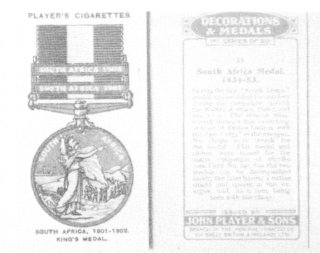

As mentioned in the introduction, because of the extreme accuracy of these cards and the information contained therein, they were subjected to censorship during the First World War. There are two sets available by Wills called 'Military Motors' one of which was not passed by the censors and then an identical one, which was subsequently passed by the censors, issued in 1916. The latter set has printed on the bottom of the front of the card 'passed for publication by the Press Bureau 21-9-16'. Card number 19 in this set is one related to Africa and it is of a motor searchlight. There is a colour picture of this vehicle on the front of the card and on the back a description of how it was designed and built for travelling on the rough roads and sandy deserts of South West Africa. It further describes how searchlights were of great service during the brilliant and victorious campaign in South West Africa, where, under the skilful leadership of General Botha, the enemy was decisively beaten and forced to surrender to the British forces.
The First World War (1914-1918)
In the numerous sets issued during this period, South Africa is not mentioned often. It is mentioned in the 'Military Motors' series section of Militaria. Wills published in 1917 a set of 50 coloured cards titled 'Allied Army Leaders' in which the various leaders of German, French, Russian, Indian and Colonial regiments were depicted. In this list are some of the leaders who had established their military reputations during the Anglo-Boer War, for example Kitchener and Smith-Dorrien. The two South African leaders illustrated in this set are number 14, General the Rt Hon L Botha PC; and Card number 27, Lieutenant General the Rt Hon J C Smuts.
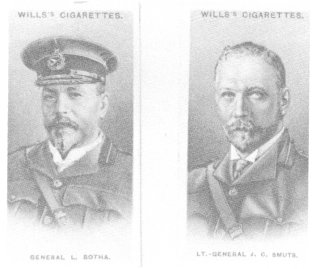
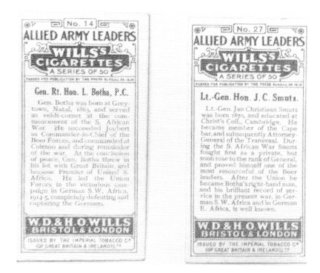
Military Portraits
This series of sets is made up mainly of black-and-white, head-and-shoulder photographs of famous military and political leaders. The set issued by Adkins and Sons in 1899 titled 'Soldiers of the Queen' has photographs of Dr Jameson, Cecil Rhodes, and Sir Alfred Milner in addition to the usual military leaders of the Anglo-Boer War. Thus General French, Sir Charles Warren, Major General N J Lyttelton, General Rawlinson, Major General A G Wauchope, Major General Hector A MacDonald are amongst those previously mentioned.
Miscellaneous Military Items
In this loosely collected section, there is one type card issued by Kinnear in 1900. It is a large card with a black and white drawing of a soldier with the caption 'A Gentleman in Khaki'. This card shows the uniform of a British soldier during the Anglo-Boer War. On the back is a description in which it states that the 'Gentleman in Khaki' is Mr Caton Woodville's celebrated picture illustrating Rudyard Kipling's 'Absentminded Beggar'.
Ogden's Issues
In the extensive Ogden's 'Guinea Gold' and 'Tab' sets, many pictures and several sets are related specifically to South Africa. For example, the Tab's set 113A. 'Leading Generals at the War', contains black and white portraits of the many military and political leaders involved in the Anglo-Boer War. The Guinea Gold unnumbered set 75S, DD1-DD185 contains many of the same individuals. Thus there is one portrait of General Louis Botha and a second one of him with a caption 'General Louis Botha, elected Commandant-General upon General Joubert's death'. There are five photographs of Sir Redvers Buller with different captions: General Sir Redvers Buller VC; General Rt Hon Sir Redvers H Buller VC; General Buller, General Sir Redvers H Buller VC. This same set of 185 cards also shows several portraits of Cecil J Rhodes, Lord Roberts, Major General Pole Carew, Lord Roberts with different titles and Ex-President Steyn. The latter part of this set is made up of a variety of illustrations, one of which is of Cape Town as seen from the sea with Table Mountain in the background. Another one is of a river crossing with ox wagons. Yet another set of Guinea Golds, made up of large cards, is titled, 'Boer War, Boxer Rebellion and Miscellaneous'. It is a numbered, large set 75X. Again, the usual portraits of participants in these military campaigns are present. There is also included a picture of HRH the Prince of Wales and the late General Joubert. Set 71S consisting of 200 cards and not labelled includes a number of British, Colonial, European and Chinese leaders. Underneath the portraits on the numbered cards are the title of the individual and a very brief description. Number one is of Edward VII with the caption 'King of Great Britain and Ireland, Emperor of India. Born 9th of November, 1841. Crowned 22nd January 1901'. Gladstone, Disraeli, the Rt Hon A J Balfour, the Rt Hon Joseph Chamberlain, the Rt Hon Cecil Rhodes and Sir Alfred Milner are all included in this set.
SUMMARY
The military section of cigarette card issues certainly covers a very broad perspective of the British Army and Colonial forces of the nineteenth and early twentieth centuries, with a significant overlap in other periods. In all of these sets, subdivided according to a personal classification, South African-related subject matter features very prominently. During the Victorian and Edwardian eras, when the British Empire reached the peak of its power and glory, two of the most striking events for Britain occurred in South Africa. In 1879, it suffered its most crushing single battle defeat at Isandhlwana and in the Anglo-Boer War of 1899-1902, it committed its largest ever force, spent the most ever on a particular war, was faced with a skilled and highly unconventional enemy and was forced to change its approach to warfare and prepare itself better for the onslaught of the First World War.
To the historian, particularly the military historian, cigarette cards provide a valuable reference source. To the nostalgic collector, to the dreamer of bygone days and to one with foresight as to the need to treasure a scarce resource, the collection of these cards provides limitless pleasure.
Return to Journal Index OR Society's Home page
South African Military History Society / scribe@samilitaryhistory.org